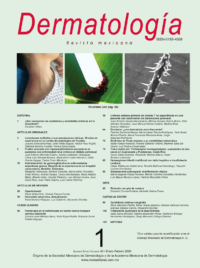Dermatol Rev Mex. 2020 enero-febrero;64(1):86-91.
María Eugenia Rosas-Romero,1 Wendy Carolina González-Hernández,2 Luis Miguel Moreno-López,3 Patricia Mercadillo-Pérez4
1 Dermatólogo pediatra, Instituto Nacional de Pediatría, Ciudad de México.
2 Residente de primer año de Dermatología, Centro Dermatológico Dr. Ladislao de la Pascua, Ciudad de México.
3 Médico adscrito al servicio de Dermatopatología.
4 Jefa del servicio de Dermatopatología.
Hospital General de México, Ciudad de México.
Resumen
ANTECEDENTES: El schwannoma es un tumor benigno de origen neural que afecta los nervios periféricos, pueden manifestarse en cualquier topografía de tejidos blandos; su localización cutánea y distalmente a las articulaciones interfalángicas proximales es muy infrecuente. El diagnóstico clínico puede complicarse porque el schwannoma subungueal puede imitar los síntomas de otros tumores sólidos subungueales, por lo que después del tratamiento quirúrgico indicado debe confirmarse el diagnóstico mediante estudio histopatológico; tiene buen pronóstico al ser rara la recidiva local.
CASO CLÍNICO: Paciente femenina de 56 años de edad, que tenía aumento de volumen asintomático en la primera lámina ungueal de la mano derecha de ocho años de evolución, con máximo crecimiento hacía tres años; tenía el antecedente de traumatismo con martillo en la misma lámina ungueal. Se realizó procedimiento quirúrgico con bloqueo anestésico digital y avulsión completa del plato ungueal, encontrando una neoformación subungueal blanquecina encapsulada de medidas 1.5 x 1.2 x 1.0 cm.
CONCLUSIONES: El schwannoma subungueal, aunque es un tumor benigno infrecuente, debe agregarse a la lista de diagnósticos diferenciales de tumores subungueales, completando el diagnóstico con estudios de imagen y confirmándolo mediante estudio histopatológico.
PALABRAS CLAVE: Schwannoma; neurilemoma; plato ungueal.
Abstract
BACKGROUND: Schwannoma is a benign neurogenic tumor that affects peripheral nerves, it can occur in any soft tissue of the body; its cutaneous localization distal to the proximal interphalangeal joints is very infrequent. The clinical diagnosis of a subungual schwannoma can be complex due to its possible similarities with another solid subungual tumors, so that, subsequent to the indicated surgical excision the diagnostic must be confirmed by histopathology, having good prognosis because of its extremely rare local recurrence.
CLINICAL CASE: A 56-year-old female patient, who had an asymptomatic volume increase in the first nail plate of the right hand of eight years of evolution, with maximum growth three years ago; She had a history of trauma with a hammer on the nail plate. A surgical procedure was performed with digital anesthetic block and complete avulsion of the nail plate, finding an encapsulated whitish subungual neoformation measuring 1.5 x 1.2 x 1.0 cm.
CONCLUSIONS: Although subungual schwannoma is a rare benign tumor, it should be added to the list of differential diagnoses of subungual tumors, completing the diagnosis with imaging studies and confirming it by histopathological study.
KEYWORDS: Schwannoma; Neurilemmoma, Nail plate.

